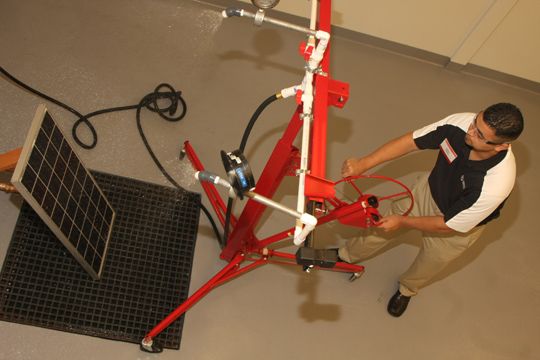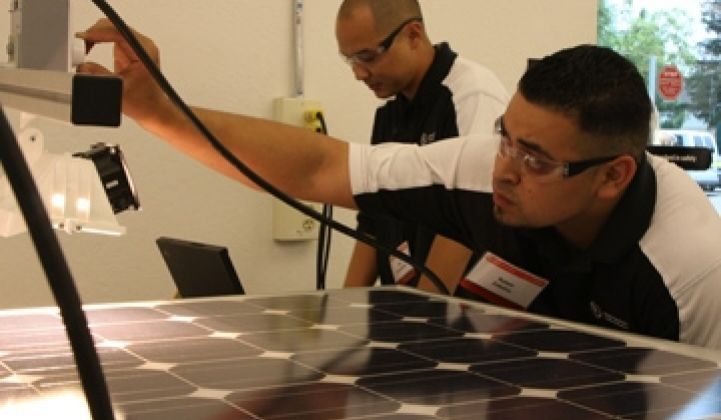Inside a large, non-discrete building in Silicon Valley is a boot camp for solar panels.
They must endure high heat, freezing temperatures and severe pounding. And they have to survive without becoming some kind of fire hazards in order to get approval from Underwriters Laboratories, the product safety and performance-testing firm based in Northbrook, Ill.
Getting certifications from organizations such as UL is crucial for solar energy equipment makers, who will find it difficult to market and sell their products without recognition from an independent lab that their goods meet performance and safety standards.
Business has been booming in recent years for the privately held UL, the company said. UL opened a 20,000-square-foot solar testing lab in San Jose, Calif., in July 2008, and expanded it earlier this year to 32,000-square-foot.
The expansion arrived two years earlier than planned, and it boosted the testing capacity, measured by the number of projects per year, by 40 percent, said Yassie Dunn, a spokeswoman for the UL. The company carries out 500 projects of all sorts of products per year, 300 of which are on solar panels, she added. Overall, the company has served over 100 solar panel makers worldwide.
"We are getting a lot of demand for testing here, and we have to be proactive and provide more space," said Christian Paxton, who manages the UL lab in San Jose and provided a tour of the space.
At the Solar Power International conference in Anaheim later this month, UL plans to announce a new service that would streamline the certification process and avoid redundant testing of solar panels that are "identical in construction, materials and performance," Dunn said.
The new service would allow sellers of a complete set of factory equipment to seek certification for their panel designs. That certification would then speed up the certification process for those equipment makers' clients when they look for UL's approval before launching their products. UL is currently providing the service as a pilot project, Dunn said.
UL and its competitors have moved fast to expand their testing facilities worldwide to accommodate the growing demand for renewable energy in Europe, the United States and Asia.
UL not expanded its lab in San Jose, it also opened one in China in 2009. The company now plans to open a lab in Germany in the first quarter of 2010 and one in Japan later next year.
Competition for business also has intensified among independent labs.
Germany-based Tüv Rheinland, which claims to be the world's largest solar technology testing organization, opened a lab in Tempe, Ariz., last year as a joint venture with Arizona State University.
In June this year, Tüv Rheinland opened a new solar testing site in Cologne, Germany. The company also has solar testing centers in China and Japan.
UL offers testing for two types of certifications: its own standard that deals with safety; and standard set by the International Electrotechnical Commission (IEC) that deals with performance.
The process can take anywhere from three months to two years, depending on the quality of the products and the turnaround time for manufacturers to fix problems and submit new samples, Paxton said.
A delay in getting certification could mean a delay in shipping products to waiting customers and generating revenues. While labs such as UL and Tüv Rheinland expand testing capacities and come up with new services to speed along the certification process, they also have to be make sure expediency doesn't trump the quality of their tests.
To minimize technical glitches during testing, companies could hire UL to work with them in the early stages of product engineering, Paxton said.
Tüv Rheinland also offers what it calls "master certificates" to factory equipment makers. The idea is the same: if the panels produced from the tool makers' lines pass performance and/or safety tests, then their customers' solar panels could undergo a streamlined process to be certified.
Oerlikon Solar, maker of amorphous-silicon thin film equipment in Switzerland, touted its master certificate in May this year.
Manufacturers typically submit 10 to 15 panels for each testing at UL. UL technicians put the panels throughout various tests to see how well they might perform after a prolonged exposure to weather elements and even extreme temperatures.
These tests also gauge the sturdiness of the insulating materials and the performance of the wiring: how quickly do they stop working or whether they leak too much current to pose fire and health hazards.
Inside one room, the panels are propped up to face lamps that shine light with intensity that is equivalent to the sun. The exposure would determine the amount of power they can generate consistently, and whether the rate of output closely matches the manufacturers' claims.
At another station, water drizzle on solar panels to simulate rain. Rain could pool inside panels, damaging wires and leading to leaky current. UL also serves up little ice balls with 1 inch in diameter to simulate hail.
A technician also ties a 30-pound weight to the junction box at the back of each panel to test the box's durability.
"That's one of the tests we see a lot of failures simply because manufacturers may not be putting enough adhesive on, so overtime that can come apart," Paxton said.
The panels are targets of an 100-pound bag at each panel a few times to look for weak spots on the glass surface and see whether it remains intact despite cracks or falls apart and makes the surface a danger for humans to touch.
Then there are 22 giant chambers where the panels stay for hours to 30 days and endure extreme temperatures and humidity, from 85-degree Celsius at 85 percent humidity to minus 40-degree Celsius. UL also has outdoor testing sites.
We will post a video of the lab tour soon.





